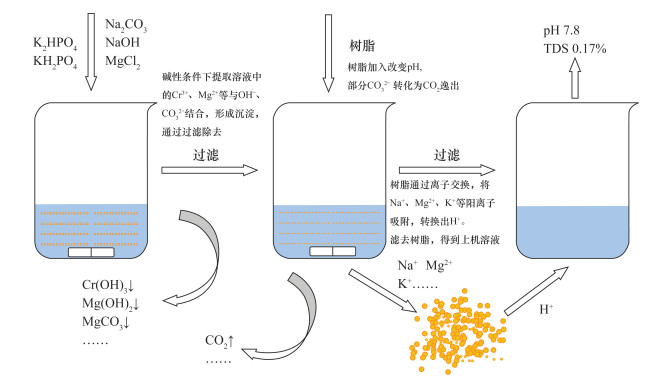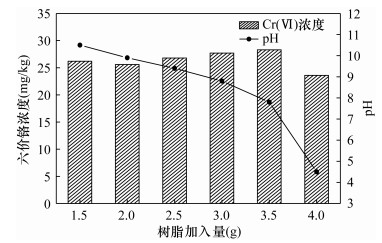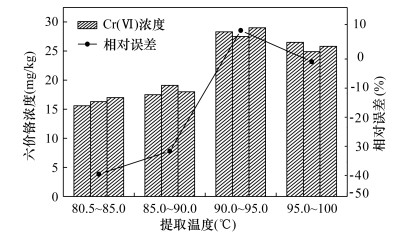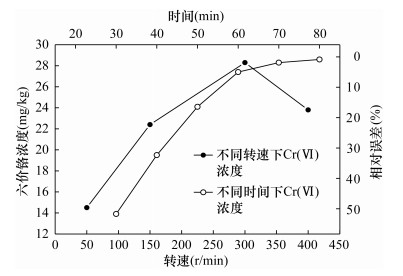Determination of Hexavalent Chromium in Soil by Inductively Coupled Plasma-Mass Spectrometry with Alkaline Digestion-Ion Exchange
-
摘要:
六价铬Cr(Ⅵ)是建设用地土壤基本监测指标之一,开展土壤六价铬监测在环境污染防治中具有重要意义。目前测定土壤Cr(Ⅵ)的标准方法为火焰原子吸收分光光度法(FAAS),其检出限为0.5mg/kg,难以满足低浓度土壤样品中Cr(Ⅵ)的分析。本文采用氢氧化钠-碳酸钠溶液提取土壤中的Cr(Ⅵ),建立了一种使用电感耦合等离子体质谱法(ICP-MS)结合阳离子交换测定土壤中低浓度Cr(Ⅵ)的方法。结果表明,将碱性提取液稀释10倍并加入3.5g阳离子交换树脂后,溶解性总固体(TDS)质量分数从2.4%降低为0.17%,基体干扰大幅度降低。同时,由于离子交换过程溶出氢离子,使得pH达到适宜的检测范围(7.5±0.5)。此外,优化了前处理条件,提取温度为90~95℃、搅拌速度300r/min、加热时间70min时,Cr(Ⅵ)提取效果最佳,相对误差(RE)仅-1.7%。本方法相对标准偏差(RSD)为3.1%~5.9%,平均相对误差介于-3.8%~-1.1%。使用F检验及t检验比较了ICP-MS法与FAAS法测试高、中、低三种浓度标准物质的结果,二者无显著性差异。由于本法采取稀释、离子交换、内标法等方式降低了基体干扰,结合ICP-MS自身灵敏度高、准确性好的特点,使得方法检出限(MDL)达到0.061mg/kg,显著低于FAAS法检出限(0.5mg/kg),可用于低浓度土壤Cr(Ⅵ)样品的测定。
-
关键词:
- 电感耦合等离子体质谱法 /
- 火焰原子吸收分光光度法 /
- 离子交换 /
- 氢氧化钠-碳酸钠溶液提取 /
- 六价铬
要点(1) 添加阳离子交换树脂除去碱液中大部分阳离子,可减少土壤提取液中的干扰物质,连续测试稳定性强。
(2) 采取稀释、添加交换树脂、使用内标法、优化仪器条件等方式能够降低方法检出限。
(3) 土壤中有还原性物质存在时,需着重将提取液的pH范围控制在7.5±0.5,防止六价铬回收率降低。
HIGHLIGHTS(1) A certain amount of cation exchange resin was added into the alkaline extraction solution, and a large number of cations were removed. Continuous analysis had strong stability.
(2) The detection limit of the method can be reduced by dilution, adding exchange resin, using an internal standard method and optimizing instrument conditions.
(3) When reducing substances exist in the soil, the pH range of the extraction solution should be controlled within 7.5±0.5 to maintain the recovery.
Abstract:BACKGROUNDHexavalent chromium Cr(Ⅵ) is one of the basic monitoring indicators of soil in construction land. It is of great significance to carry out soil hexavalent chromium monitoring in the prevention and control of environmental pollution. At present, the standard method of hexavalent chromium in soil is flame atomic absorption spectrometry (FAAS). The FAAS method has a high detection limit (0.5mg/kg), and serious matrix effect, and cannot meet the analysis of Cr(Ⅵ) in low-concentration soil samples.
OBJECTIVESTo establish a convenient and high sensitivity method for determination of low-concentration hexavalent chromium in soil.
METHODSAn ion-exchange-inductively coupled plasma-mass spectrometry (ICP-MS) method was developed to determine the content of hexavalent chromium in soil by extracting hexavalent chromium with alkali solution. The resin content, mixing speed, extraction temperature and extraction time were studied. The measurement results were compared with the flame atomic absorption spectrophotometry (FAAS) method.
RESULTSThe results showed that the total dissolved solids (TDS) mass fraction was reduced from 2.4% to 0.17% after the alkaline extraction solution was diluted 10 times and 3.5g of cation exchange resin was added, and the matrix interference was greatly reduced. At the same time, due to the dissolution of hydrogen ions in the ion exchange process, the pH reached a suitable detection range (7.5±0.5). The pretreatment conditions were optimized. When the extraction temperature was 90-95℃, the stirring speed was 300 rpm, and the heating time was 70 min, the extraction effect of Cr(Ⅵ) was the best, and the relative error was -1.7%. The relative standard deviation (RSD) was 3.1%-5.9%, and the average relative error was -3.8% to -1.1%. F test and t test were used to compare the test results of high, medium and low concentration standard substances by ICP-MS and FAAS, and there was no significant difference between the two methods. The method detection limit (MDL) was 0.061 mg/kg.
CONCLUSIONSSince this method adopts dilution, ion exchange, internal standard method, to reduce matrix interference, combined with the high sensitivity and good accuracy of ICP-MS, the method detection limit (MDL) is significantly lower than the detection limit of FAAS method (0.5mg/kg). This method can be used for the determination of low-concentration soil Cr(Ⅵ) samples.

-
多环芳烃(PAHs)是一种自然界中广泛分布的半挥发性有机污染物,该类化合物由两个及以上的苯环结构组成,其主要来源是化石燃料的不完全燃烧[1]。该类污染物对动物体具有较大的致癌、致畸、致突变的危害,其中致癌性最大的是4~6环的稠环PAHs[2]。该类化合物在环境中分布广泛,但由于环境基体复杂且其含量较低,很难直接、快速地对样品中PAHs进行分析[3-4],常常需要结合样品前处理技术进行富集。常规的样品前处理方法,如索氏提取、加速溶剂提取、液液萃取等方式耗时长,且使用大量有机溶剂,容易对环境造成二次污染,因此有必要建立一种样品前处理过程高效绿色、分析检测快速灵敏的新方法。
固相微萃取(SPME)是一种集分离、富集、进样于一体的样品前处理技术[5-6],在操作过程中避免了大量有机试剂的使用,在保证绿色环保的基础上具有提高目标物富集效率[7-10]的优点。已有很多研究者将SPME技术应用于PAHs的检测中并取得了较好的萃取效果[4, 11]。对于SPME技术而言,涂层的性能是制约萃取效率和目标分析物种类的关键因素[12-14],是目前SPME技术研究的热点问题。金属有机骨架化合物(MOFs)是一类独特的多孔材料[15-16],其永久性纳米孔隙率、高比表面积、均匀且可调节的孔径、易于功能化和表面改性[17]的特点,使MOFs材料在分离、气体储存、分子传感、富集和催化等方面具有广阔的应用前景[18-22]。然而,包括MOF-5和HKUST-1在内的MOFs材料在水溶液中稳定性较差,一定程度上了限制了它的实际应用。研究得到MIL-53(M=Al,Cr,Fe)是一种常见的金属骨架有机化合物,其中心金属离子可以是三价铁、铝或铬离子,配体为对苯二甲酸,是一类合成简便、性能优良、化学稳定性较好的MOFs材料,且在吸附水时其孔隙率没有明显变化[23]。Chen等[24]采用中性硅酮胶黏接法制备了MIL-53(Al,Cr,Fe)SPME涂层纤维,进行了浸入式萃取研究,并结合GC-MS/MS检测,结果显示三种MIL-53(M)涂层对PAHs都具有较好的萃取效率。该研究结果表明,该类水稳定性MOFs材料的SPME涂层对水样中芳香族化合物的富集和检测具有很好的应用前景,特别是对于浸入式萃取模式下萃取环境水样中难挥发的PAHs类物质具有较大的优势。传统的MOFs涂层制作方式,如水热原位沉积法、溶胶-凝胶法(sol-gel)、黏合固定法等往往存在步骤复杂、涂层机械强度较差等不足[21, 25-26]。
本研究在MOFs材料优良的吸附性能以及较好的水稳定性的基础上,采用金属基质材料原位自转化的方式[27],在铁丝基质上直接生长MOFs涂层,该过程使得金属丝不仅作为支撑吸附剂的基质材料,而且还作为铁源参与MOFs材料的形成,不需要再添加金属盐,一定程度上节约了成本,避免重金属离子对环境的二次污染。将该涂层应用于环境水体中PAHs的萃取,并结合GC-MS进行检测,建立了环境水样中7种PAHs的SPME检测方法,以期为高效SPME涂层的简单、快速制备提供新思路。
1. 实验部分
1.1 材料和主要试剂
铁丝(直径为0.2mm,纯度99.9%,赛维精密金属材料有限公司)。
苯并(a)蒽(BaA,99.8%);䓛(CHR,99.8%);苯并(b)荧蒽(BbF,99.7%);苯并(k)荧蒽(BKF,100%);苯并(a)芘(BaP,99.8%);茚苯(1, 2, 3-cd)芘(IPY,98.8%);二苯并(a, n)蒽(DBA,98.3%);苯并(ghi)芘(二萘嵌苯)(BPE,98.4%,美国AccuStandard公司);100μm PDMS聚二甲基硅氧烷涂层(美国Supelco公司)。
对苯二甲酸(H2BDC,98%)、六水氯化铁(FeCl3·6H2O,麦克林生化科技有限公司);三乙胺(TEA,国药集团);超纯水;N, N-二甲基甲酰胺(DMF,国药集团);乙醇(国药集团)。丙酮(美国Tedia公司);甲醇(美国Tedia公司)。
上述试剂除丙酮和甲醇为色谱纯,其余试剂为分析纯。
1.2 仪器及工作条件
气相色谱-质谱仪(GCMS-QP2010plus,日本岛津公司)。该仪器测试PAHs条件:载气为高纯氦(99.999%);色谱柱为Rtx-1MS(30m×0.25mm×0.25μm);流量1.2mL/min,不分流进样;进样口260℃;离子源温度250℃;接口温度260℃;升温程序:初始温度50℃,保持2min,以20℃/min升至230℃,再以2.5℃/min升至250℃,保持2min。检测方式特征离子扫描(SIM)。
X射线粉晶衍射仪(D8-FOCUS,德国布鲁克科技有限公司);傅里叶变换红外光谱仪(Nicolet 6700,美国ThermoFisher公司);高分辨率场发射扫描电子显微镜(SU8010,日本日立公司);全自动进样装置(MPS,德国Gerstel科技有限公司)。
1.3 实验方法
1.3.1 固相微萃取涂层IW@MIL-53(Fe)的制作
将直径为0.2mm的铁丝截为3cm的一段,置于10mol/L盐酸中反应15min,待反应至合适尺寸后取出铁丝,随后将其依次置于丙酮、甲醇、超纯水的条件下超声处理30min,取出铁丝于65℃烘箱中干燥12h备用。取0.65g对苯二甲酸溶于50mL N, N-二甲基甲酰胺中,加入5mL三乙胺,室温下搅拌15min;将反应液置于100mL高压反应釜中,将处理好的铁丝放入反应液中,并将密封好的高压反应釜置于180℃的条件下反应12h。将制作好的涂层置于100℃的真空烘箱中12h。将自制涂层在GC进样口280℃老化2h用以去除多余的溶剂。
1.3.2 金属有机骨架化合物多孔膜MIL-53(Fe)水热合成
将810mg六水氯化铁和498mg对苯二甲酸溶于15mL N, N-二甲基甲酰胺中,常温搅拌10min,置于50mL反应釜中150℃保持6h,带溶液冷却至室温后,超纯水清洗,转移至600mL超纯水中分散24h后,过滤,60℃烘干24h[23, 28-29]。
1.3.3 浸入式SPME过程
将制好的样品溶液转移到MPS自动进样平台特定区域,由自动进样器控制自制涂层装置在设定的萃取温度、萃取时间的条件下完成对PAHs的萃取,接着萃取了目标物的涂层被转移到GC-MS的进样口进行解吸分析。
1.3.4 实际样品采集和制备
样品一采自东湖(武汉);样品二采自长江(武汉)。采集时间均为同一天的上午8:00~10:00。将采集的环境水样放置在25℃的室温下静置1h后经0.45μm微孔滤膜过滤,将处理好的水样取10mL于20mL顶空瓶中并放置在4℃的条件下备用。
2. 结果与讨论
2.1 自制IW@MIL-53(Fe)涂层表征
自制IW@MIL涂层通过扫描电子显微镜进行表征(图 1)。图 1a为经盐酸蚀刻的铁丝,可以看出经盐酸处理后铁丝表面呈“鳞片状”,该表面形状与光滑的铁丝表面相比,可以增大铁丝表面与反应液的接触面积;图 1b为经过水热反应后铁丝表面的变化,一层均匀的“树皮褶皱”材料覆盖在铁丝表面,铁丝反应前后直径无明显变化,由161μm变为163μm,局部放大(图 1c)可以看出该层状物质是由小的片状颗粒堆积而成;图 1d为该涂层的截面图,从该图中可以得出涂层平均厚度为10μm;为保护涂层外侧的吸附材料,避免在浸入式萃取过程中脱落和污染,涂层外涂覆了一层薄薄的中性硅酮胶加以固定,如图 1e、1f所示,通过与图 1b的对比,可以看出中性硅酮胶将吸附材料紧紧地包覆在胶层内部,其厚度约为15μm。
从X射线衍射图谱(图 2a)可以看出,水热合成的MIL-53(Fe)与原位转化的材料在衍射峰的位置上对应良好,可以证明为同一种物质,表明铁丝上已原位转化出一层MIL-53(Fe)的薄膜。通过红外光谱图(图 2b)可以看出,红外光谱的所有振动带与水热合成的MIL-53(Fe)的数据吻合良好。红外光谱在近1645cm-1处表现出羧基的强烈伸缩振动,证明了对苯二甲酸中的—COOH基团与Fe金属离子成功结合。
2.2 自制IW@MIL-53(Fe)涂层萃取条件的优化
2.2.1 萃取温度
SPME在萃取的过程温度可以促进待测物在基质中的扩散以及扩大待测物的分配系数,加快与涂层之间的分配平衡,从而缩短达到平衡所需的时间。但随着温度的升高,涂层本身萃取相的分配系数也会下降,导致涂层灵敏度的降低[30-32]。为获取最佳的萃取温度以发挥SPME涂层最佳的萃取性能,实验中在萃取时间为50min,解吸温度为280℃,解吸时间为4min的条件下对萃取温度进行优化。图 3a结果表明,随着温度的升高,涂层的萃取性能也随之增强,直到80℃达到最佳性能,随之性能略有下降。因此该自制涂层的最佳萃取温度为80℃。
2.2.2 萃取时间
由于SPME技术是建立在平衡吸附基础上的样品前处理技术,需要使待测组分与萃取相达到平衡状态时,才能够保证测试数据的准确性和萃取过程的重现性。为保证在最短的时间内完成有效的萃取过程,实验设置了自制涂层在萃取温度为80℃,解吸温度为280℃,解吸时间为4min的条件下分别萃取5、10、20、25、30、40、50、60min。图 3b结果表明,随着时间的增加,自制涂层在萃取50min后逐渐达到萃取平衡。因此选取的最佳萃取时间为50min。
2.2.3 解吸时间
为确定一个最佳的解吸时间,实验在萃取温度为80℃,萃取时间为50min,解吸温度为280℃的条件下设置了1、2、3、4、5min五个解吸时间。图 3c结果表明,解吸4min后,涂层上的目标分析物已经解吸完全。因此该自制涂层的最佳解吸时间为4min。
2.2.4 解吸温度
SPME进样的解吸温度需要稍高于直接进样的温度,温度越高,涂层上的物质解吸得越完全,但这也存在着目标分析物分解以及高温降低涂层使用寿命的问题,因此解吸时不宜使用过高的温度。为确定一个合适的解吸温度,实验在萃取温度为80℃,萃取时间为50min,解吸时间为4min的条件下设置了240℃、250℃、260℃、270℃、280℃、290℃六个解吸温度进行测试。图 3d结果表明,解吸温度在280℃的条件下,测试性能最佳。因此该自制涂层的最佳解吸温度为280℃。
2.2.5 离子强度
无机盐的加入一方面可以改变样品溶液中的相界面性质,进而影响组分之间的分配系数;另一方面,加入无机盐之后样品溶液的离子强度增强,产生盐析效应,降低了目标分析物在溶液中的溶解度,有利于涂层的萃取。为了确定加入无机盐的用量,实验设计了萃取温度为80℃,萃取时间为50min,解吸温度为280℃,解吸时间为4min,以饱和食盐水为盐溶液的最大浓度,将其稀释为0%、15%、30%、50%、65%、80%、100%的氯化钠溶液。图 4结果表明,在氯化钠浓度为50%的条件下萃取效率达到最佳。因此该自制涂层的最佳盐浓度为50%的饱和氯化钠溶液。
2.3 自制IW@MIL-53(Fe)涂层性能评价
为了考察自制涂层的萃取性能,实验选取性能稳定的商用PDMS涂层为参照,以7种多环芳烃为目标分析物,在最优萃取条件下与商用100μm PDMS涂层萃取多环芳烃的性能进行了比较,对比结果如图 5a所示。实验结果表明,自制涂层的萃取性能略优于商用涂层1~2倍,表现出良好的萃取性能。同时比较了外涂的硅酮胶的吸附能力,得到IW@MIL-53(Fe)涂层的吸附性能主要是来自MIL-53(Fe)材料。
为了测试涂层的使用次数,实验比较了涂层使用1次、60次、90次、120次萃取目标分析物的萃取性能,对比结果如图 5b所示。从图中可以看出,该涂层在使用120次之后萃取性能并没有明显下降,因此,该自制涂层具有较长的使用寿命,使用次数大于120次,显著优越于商用涂层的有效使用次数(< 80次)[33]。自制涂层良好的稳定性,是由于MIL-53(Fe)本身具有良好的水稳定性,此外外涂的硅酮胶也起到了很好的保护作用,避免了外层涂层材料的脱落,提高了涂层的重复使用次数。
在最佳的实验条件下,考察了IW@MIL-53(Fe)涂层结合GC-MS测定7种多环芳烃的分析性能(表 1),得到该方法的检出限(LOD)为0.03~2.25ng/L,定量限(LOQ)为0.10~7.50ng/L,线性范围为250~10000ng/L,相关系数为0.9903~0.9991;同一根涂层测定结果的相对标准偏差(RSD,n=5)为3.1%~10.4%;不同根涂层测定结果的相对标准偏差(RSD,n=3)为3.0%~9.5%。
表 1 IW@MIL-53(Fe)涂层SPME-GC-MS分析7种PAHs的分析性能Table 1. Analysis performance of 7 kinds of PAHs by IW@MIL-53(Fe) coating with SPME-GC-MS分析物 线性范围(ng/L) R2 LOD (ng/L, S/N=3) LOQ (ng/L, S/N=10) RSD(%) 涂层内(n=5) 涂层间(n=3) BaA 250~10000 0.9991 0.03 0.10 3.1 6.7 CHR 250~10000 0.9922 0.13 0.43 6.2 3.0 BbF 250~10000 0.9922 0.11 0.37 8.9 5.7 BKF 250~10000 0.9903 0.26 0.87 5.2 5.5 BaP 250~10000 0.9933 0.36 1.20 7.7 6.0 IPY 250~10000 0.9962 1.50 5.00 10.4 9.5 BPE 250~10000 0.9982 2.25 7.50 10.4 2.5 2.4 实际样品分析
按照1.3节的实验方法,采用自制IW@MIL-53(Fe)涂层结合GC-MS分析方法对东湖和长江的实际水样进行分析,目标分析物浓度低于检出限,结果未检出。对样品进行加标回收实验,得到该方法的回收率为80.1%~108.5%(表 2)。
表 2 实际水样中PAHs分析结果Table 2. Analytical results of PAHs in actual water samples分析物 东湖水样 长江水样 浓度(ng/L) 加标浓度(ng/L) RSD (%, n=3) 回收率(%) 浓度(ng/L) 加标浓度(ng/L) RSD (%, n=3) 回收率(%) BaA ND 500 11.6 89.3 ND 500 3.5 80.1 CHR ND 500 8.0 102.3 ND 500 7.0 92.5 BbF ND 500 8.8 96.5 ND 500 10.6 84.6 BKF ND 500 5.5 91.1 ND 500 6.4 89.5 BaP ND 500 11.1 90.6 ND 500 9.6 83.0 IPY ND 500 8.6 91.8 ND 500 5.1 108.5 BPE ND 500 4.9 99.7 ND 500 14.4 91.8 注:ND表示未检出。 3. 结论
为了提高固相微萃取涂层的萃取效率和机械强度,本文通过原位自转化的方式在铁丝上生长出一层MIL-53(Fe)的MOFs膜,该方法在转化过程中,铁丝既作为涂层纤维的基质又可以为MIL-53(Fe)的生成提供铁离子,不需要向反应体系中额外添加金属盐。研究结果表明:采用金属基质原位自转化的方式制备固相微萃取涂层,具有涂层制备快速简便、环境友好、性质稳定等优点。
将该新材料用作固相微萃取涂层,以7种PAHs作为目标分析物,以浸入式萃取的模式并结合GC-MS作为检测手段验证了其萃取性能,应用于长江及东湖水样中PAHs的测定,得到加标回收率为80.1%~108.5%。建立的SPME-GC-MS方法实现了有机污染物的快速、灵敏检测,显示出良好的应用前景。
-
表 1 采用ICP-MS和FAAS法测定土壤中Cr(Ⅵ)的检出限
Table 1 Detection limit of Cr(Ⅵ) in soil by ICP-MS and FAAS
分析方法 提取液平行测定的Cr(Ⅵ)浓度(mg/L) 标准偏差(mg/kg) 方法检出限MDL(mg/kg) 1 2 3 4 5 6 7 ICP-MS(本文方法) 0.1902 0.2004 0.1578 0.1822 0.1736 0.2148 0.1690 0.01949 0.061 FAAS 2.06 1.90 1.72 1.84 1.68 2.02 1.78 0.145 0.5 表 2 采用ICP-MS和FAAS法测定Cr(Ⅵ)的精密度及相对误差
Table 2 Precision and relative error of ICP-MS and FAAS determination of Cr(Ⅵ)
标准物质编号 Cr(Ⅵ)浓度标准值(mg/kg) 分析方法 土壤中Cr(Ⅵ)浓度平行测定值(mg/kg) 相对误差(%) RSD(%) 1 2 3 4 5 6 7 平均值 RMH-A048 28.8±2.7 ICP-MS 27.1 28.3 26.7 29 27.5 28.3 26.9 27.7 -3.8 3.1 FAAS 28.3 31.1 26.9 27.5 28.3 26.8 27.7 28.1 -2.4 5.2 RMU041 5.10±0.67 ICP-MS 5.11 4.93 5.02 4.67 4.52 4.81 5.30 4.91 -3.7 5.4 FAAS 4.39 5.73 4.52 4.39 4.64 5.13 4.45 4.75 -6.9 10.6 GBW(E)070251 0.92±0.09 ICP-MS 0.84 0.86 0.93 0.89 0.96 0.99 0.92 0.91 -1.1 5.9 FAAS 0.70 0.83 0.96 0.82 0.96 0.91 0.63 0.83 -9.8 15.3 -
[1] Chen J S, Wei F S, Zheng C J, et al. Background concentrations of elements in soils of China[J]. Water Air and Soil Pollution, 1991, 57/58(1): 699-712. doi: 10.1007/BF00282934
[2] 陈雅丽, 翁莉萍, 马杰, 等. 近十年中国土壤重金属污染源解析研究进展[J]. 农业环境科学学报, 2019, 38(10): 2219-2238. https://www.cnki.com.cn/Article/CJFDTOTAL-NHBH201910002.htm Chen Y L, Weng L P, Ma J, et al. Review on the last ten years of research on source identification of heavy metal pollution in soils[J]. Journal of Agro-Environment Science, 2019, 38(10): 2219-2238. https://www.cnki.com.cn/Article/CJFDTOTAL-NHBH201910002.htm
[3] Liang J L, Huang X M, Yan J W, et al. A review of the formation of Cr(Ⅵ) via Cr(Ⅲ) oxidation in soils and groundwater[J]. Science of the Total Environment, 2021, 774: 145762. doi: 10.1016/j.scitotenv.2021.145762
[4] Zhang X W, Tong J X, Hu B X, et al. Adsorption and desorption for dynamics transport of hexavalent chromium (Cr(Ⅵ)) in soil column[J]. Environmental Science and Pollution Research, 2018, 25: 459-468. doi: 10.1007/s11356-017-0263-0
[5] Nagaraj P, Aradhana N, Shivakumar A, et al. Spe-ctrophotometric method for the determination of chromium (Ⅵ) in water samples[J]. Environmental Monitoring and Assessment, 2009, 157: 575-582. doi: 10.1007/s10661-008-0557-2
[6] Fikirte Z, Meareg A. Determination of the level of hexavalent, trivalent, and total chromium in the discharged effluent of Bahir Dar tannery using ICP-OES and UV-visible spectrometry[J]. Cogent Chemistry, 2018, 4(1): 1534566. doi: 10.1080/23312009.2018.1534566
[7] Miyake Y, Tokumura M, Iwazaki Y, et al. Determination of hexavalent chromium concentration in industrial waste incinerator stack gas by using a modified ion chromatography with post-column derivatization method[J]. Journal of Chromatography A, 2017, 1502: 24-29. doi: 10.1016/j.chroma.2017.04.046
[8] Borai E H, El-Sofany E A, Abdel-Halim A S. Speciation of hexavalent chromium in atmospheric particulate samples by selective extraction and ion chromatographic determination[J]. TrAC Trends in Analytical Chemistry, 2002, 21(11): 741-745. doi: 10.1016/S0165-9936(02)01102-0
[9] 林海兰, 谢沙, 文卓琼, 等. 碱消解-火焰原子吸收法测定土壤和固体废物中六价铬[J]. 分析试验室, 2017, 36(2): 198-202. https://www.cnki.com.cn/Article/CJFDTOTAL-FXSY201702017.htm Lin H L, Xie S, Weng Z Q, et al. Determination of chromium (Ⅵ) in soil and solid waste by alkaline digestion-flame atomic absorption spectrometry[J]. Chinese Journal of Analysis Laboratory, 2017, 36(2): 198-202. https://www.cnki.com.cn/Article/CJFDTOTAL-FXSY201702017.htm
[10] Abkenar S D, Hosseini M, Dahaghin Z, et al. Speciation of chromium in water samples with homogeneous liquid-liquid extraction and determination by flame atomic absorption spectrometry[J]. Bulletin of the Korean Chemical Society, 2010, 31(10): 2813-2818. doi: 10.5012/bkcs.2010.31.10.2813
[11] Samira P, Mohammad B, Fatemeh Z, et al. Preconcentration and ultra-trace determination of hexavalent chromium ions using tailor-made polymer nanoparticles coupled with graphite furnace atomic absorption spectrometry: Ultrasonic assisted-dispersive solid-phase extraction[J]. New Journal of Chemistry, 2018, 42 (12): 10357-10365. doi: 10.1039/C8NJ01608A
[12] 炼晓璐, 魏洪敏, 甄长伟, 等. 碱消解-火焰原子吸收光谱法测定土壤中六价铬[J]. 中国无机分析化学, 2021, 11(3): 23-27. https://www.cnki.com.cn/Article/CJFDTOTAL-WJFX202103005.htm Lian X L, Wei H M, Zhen C W, et al. Determination of hexavalent chromium in soil by alkali digestion flame atomic absorption spectrometry[J]. Chinese Jorunal of Inorganic Analytical Chemistry, 2021, 11(3): 23-27. https://www.cnki.com.cn/Article/CJFDTOTAL-WJFX202103005.htm
[13] 李强, 高存富, 曹莹, 等. 固体样品六价铬的检测比对和验证[J]. 环境工程, 2020, 38(6): 47-51. https://www.cnki.com.cn/Article/CJFDTOTAL-HJGC202006008.htm Li Q, Gao C F, Cao Y, et al. Comparison and verification of hexavalent chromium detection in solid samples[J]. Environmental Engineering, 2020, 38(6): 47-51. https://www.cnki.com.cn/Article/CJFDTOTAL-HJGC202006008.htm
[14] 赵庆令, 李清彩, 谭现锋, 等. 微波碱性体系消解-电感耦合等离子体发射光谱法测定固体废物中的六价铬[J]. 岩矿测试, 2021, 40(1): 103-110. http://www.ykcs.ac.cn/cn/article/id/3e1263d3-6d6c-43f1-89da-736a5e4179b5 Zhao Q L, Li Q C, Tan X F, et al. Determination of hexavalent chromium in solid waste by inductively coupled plasma-optical emission spectrometry with microwave digestion[J]. Rock and Mineral Analysis, 2021, 40(1): 103-110. http://www.ykcs.ac.cn/cn/article/id/3e1263d3-6d6c-43f1-89da-736a5e4179b5
[15] 秦婷, 董宗凤, 吕晓华, 等. 碱消解-电感耦合等离子体发射光谱(ICP-OES)法测定土壤中六价铬[J]. 中国无机分析化学, 2019, 9(6): 10-13. https://www.cnki.com.cn/Article/CJFDTOTAL-WJFX201906003.htm Qin T, Dong Z F, Lyh X H, et al. Determination of hexavalent chromium in soil by alkaline digestion-inductively coupled plasma optical emission spectrometry (ICP-OES)[J]. Chinese Jorunal of Inorganic Analytical Chemistry, 2019, 9(6): 10-13. https://www.cnki.com.cn/Article/CJFDTOTAL-WJFX201906003.htm
[16] 陈波, 胡兰. 电感耦合等离子体质谱法测定土壤样品中六价铬的前处理方法研究[J]. 理化检验(化学分册), 2021, 57(4): 358-361. https://www.cnki.com.cn/Article/CJFDTOTAL-LHJH202104016.htm Chen B, Hu L. Study on pretreatment method for determination of hexavalent chromium in soil samples by inductively coupled plasma mass spectrometry[J]. Testing and Chemical Analysis (Part B: Chemical Analysis), 2021, 57(4): 358-361. https://www.cnki.com.cn/Article/CJFDTOTAL-LHJH202104016.htm
[17] Spanua D, Monticellia D, Binda G, et al. One-minute highly selective Cr(Ⅵ) determination at ultra-trace levels: An ICP-MS method based on the on-line trapping of Cr(Ⅲ)[J]. Journal of Hazardous Materials, 2021, 412: 125280. doi: 10.1016/j.jhazmat.2021.125280
[18] Barałkiewicz D, Pikosz B, Belter M, et al. Speciation analysis of chromium in drinking water samples by ion-pair reversed-phase HPLC-ICP-MS: Validation of the analytical method and evaluation of the uncertainty budget[J]. Accreditation and Quality Assurance, 2018, 18: 391-401.
[19] Christopher T M, Carleton R B, Ruth E W, et al. Modi-fications to EPA method 3060A to improve extraction of Cr(Ⅵ) from chromium ore processing residue-contaminated soils[J]. Environmental Science & Technology, 2017, 51: 11235-11243.
[20] Catalani S, Fostinelli J, Gilberti M E, et al. Application of a metal free high performance liquid chromatography with inductively coupled plasma mass spectrometry (HPLC-ICP-MS) for the determination of chromium species in drinking and tap water[J]. International Journal of Mass Spectrometry, 2015, 387: 31-37.
[21] 刘卫, 林建, 杨一, 等. 碱消解-离子色谱与电感耦合等离子体质谱(IC-ICP-MS)法测定土壤中的六价铬[J]. 中国无机分析化学, 2022, 12(1): 8-12. https://www.cnki.com.cn/Article/CJFDTOTAL-WJFX202201002.htm Liu W, Lin J, Yang Y, et al. Determination of hexavalent chromium in soil by alkaline digestion-ion chromatography and inductively coupled plasma mass spectrometry (IC-ICP-MS)[J]. Chinese Journal of Inorganic Analytical Chemistry, 2022, 12(1): 8-12. https://www.cnki.com.cn/Article/CJFDTOTAL-WJFX202201002.htm
[22] Imanaka S, Hayashi H. Behavior of hexavalent chromium in the water supply system by IC-ICP-MS method[J]. Water Supply, 2013, 13(1): 96-103.
[23] Xiao W D, Zhang Y B, Li T Q, et al. Reduction kinetics of hexavalent chromium in soils and its correlation with soil properties[J]. Journal of Environmental Quality, 2012, 41(5): 1452-1458.
[24] Mädler S, Sun F, Tat C, et al. Trace-level analysis of hexavalent chromium in lake sediment samples using ion chromatography tandem mass spectrometry[J]. Journal of Environmental Protection, 2016, 7: 422-434.
[25] Huo D W, Kingston H M S. Correction of species transfor-mations in the analysis of Cr(Ⅵ) in solid environmental samples using speciated isotope dilution mass spectrometry[J]. Analytical Chemistry, 2000, 72: 5047-5054.
[26] Eary L E, Davis A. Geochemistry of an acidic chromium sulfate plume[J]. Applied Geochemistry, 2007, 22: 357-369.
[27] Novotnik B, Zuliani T, Šanar J, et al. The determination of Cr(Ⅵ) in corrosion protection coatings by speciated isotope dilution ICP-MS[J]. Journal of Analytical Atomic Spectrometry, 2012, 27: 1484-1493.
[28] 冷远鹏, 薛晓康, 章明洪. 土壤碱消解检测六价铬的铬还原问题及质控结果分析[J]. 安徽农业科学, 2019, 47(21): 206-208. https://www.cnki.com.cn/Article/CJFDTOTAL-AHNY201921064.htm Leng Y P, Xue X K, Zhang M H. Determination of chromium reduction of hexavalent chromium by soil alkaline digestion and analysis of quality control results[J]. Journal of Anhui Agricultural Sciences, 2019, 47(21): 206-208. https://www.cnki.com.cn/Article/CJFDTOTAL-AHNY201921064.htm
[29] 刘海明, 武明丽, 成景特, 等. 酸溶分解-电感耦合等离子体质谱内标法测定地质样品中的痕量银[J]. 岩矿测试, 2021, 40(3): 444-450. doi: 10.15898/j.cnki.11-2131/td.202002190018 Liu H M, Wu M L, Cheng J T, et al. Determination of trace silver in geological samples by inductively coupled plasma-mass spectrometry with acid decomposition and internal standard calibration[J]. Rock and Mineral Analysis, 2021, 40(3): 444-450. doi: 10.15898/j.cnki.11-2131/td.202002190018
[30] Vanhaecke F, Vanhoe H, Dams R, et al. The use of internal standards in ICP-MS[J]. Talanta, 1992, 39(7): 737-742.
[31] 史凯, 朱建明, 吴广亮, 等. 地质样品中高精度铬同位素分析纯化技术研究进展[J]. 岩矿测试, 2019, 38(3): 341-353. doi: 10.15898/j.cnki.11-2131/td.201805130059 Shi K, Zhu J M, Wu G L, et al. A review on the progress of purification techniques for high precision determination of Cr isotopes in geological samples[J]. Rock and Mineral Analysis, 2019, 38(3): 341-353. doi: 10.15898/j.cnki.11-2131/td.201805130059
[32] Larsen K K, Wielandt D, Schiller M, et al. Chromatographic speciation of Cr(Ⅲ)-species, inter-species equilibrium isotope fractionation and improved chemical purification strategies for high-precision isotope analysis[J]. Journal of Chromatography A: Including Electrophoresis and Other Separation Methods, 2016, 1443: 162-174.
[33] 田晓芳, 高显超, 国静, 等. 过渡金属离子Mn(Ⅱ)和Fe(Ⅲ)对草酸还原Cr(Ⅵ)的催化作用[J]. 南京农业大学学报, 2009, 32(4): 160-164. https://www.cnki.com.cn/Article/CJFDTOTAL-NJNY200904031.htm Tian X F, Gao X C, Guo J, et al. Catalytic role of Mn(Ⅱ) and Fe(Ⅲ) in the reduction of Cr(Ⅵ) by oxalic acid[J]. Journal of Nanjing Agricultural university, 2009, 32(4): 160-164. https://www.cnki.com.cn/Article/CJFDTOTAL-NJNY200904031.htm
[34] Vitale R J, Mussoline G R, Rinehimer K A, et al. Extrac-tion of sparingly soluble chromate from soils: Evaluation of methods and Eh-pH effects[J]. Environmental Science & Technology, 1997, 31(2): 390-394.
-
期刊类型引用(2)
1. 李丙阳,陈佳,邱洪灯. 骨架材料在固相微萃取方面的应用研究进展. 分析测试学报. 2025(02): 195-210 .  百度学术
百度学术
2. 乔淞汾,秦冲,刘爱琴,安彩秀,刘安,杨利娟,孙凯茜,冉卓. 超声萃取-高效液相色谱-串联质谱法测定土壤中三种硝基酚类化合物. 岩矿测试. 2024(03): 501-508 .  本站查看
本站查看
其他类型引用(0)




 下载:
下载:








 京公网安备 11010202008159号
京公网安备 11010202008159号